

Backpacking in Iceland offers immense variety for outdoor enthusiasts, from the rugged volcanic landscape to glacial mountain peaks, including popular destinations like the Landmannalaugar region.
And that’s what this post is all about – backpacking in Iceland. We’ll provide tips to help you prepare for backpacking in this incredible country as well as showcase the TOP 5 multi-day trails in Iceland.
Interested? Let’s get started.
Explore Iceland’s amazing long trails for unforgettable adventures with beautiful scenery and wildlife:
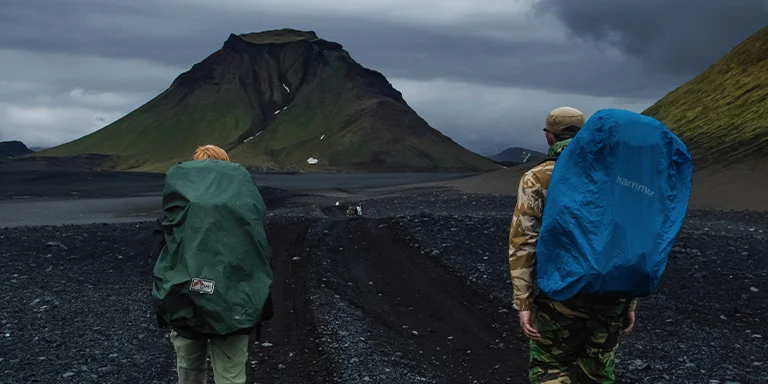
Length: 32.4 mi / 52.1 km
Type: Point to point
Difficulty: Hard
Elevation Gain: 5429 ft / 1655 m
Location: Fjallabak Nature Reserve
Estimated Hiking Calorie Burn: 3945 calories
More Details: See on AllTrails
The iconic Laugavegur Trail is a 32 mile backpacking route through Iceland’s rugged interior. Trek past geothermal springs, lava fields, canyons, and colorful mountains. Cross frothing rivers and black sand deserts. Travel from the hot springs of Landmannalaugar to the verdant valleys of Þórsmörk over 4-5 days. Camp at designated sites along the way. Experience the true beauty of Iceland’s wild landscapes on this challenging yet rewarding trek. Go between June and September when weather is mildest.
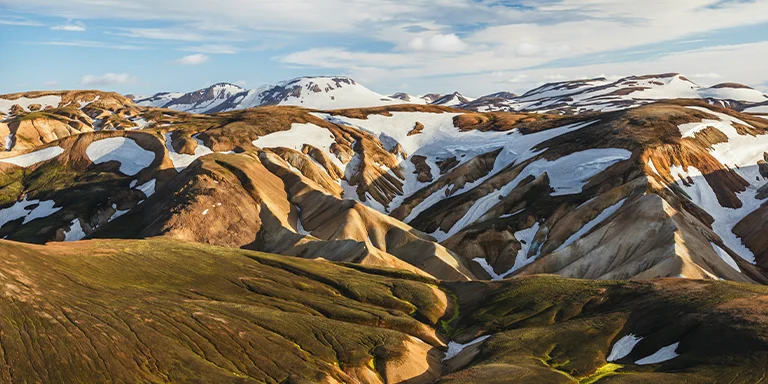
Length: 32.9 mi / 52.9 km
Type: Point to point
Difficulty: Hard
Elevation Gain: 6784 ft / 2 068 m
Location: Skógar
Estimated Hiking Calorie Burn: 4135 calories
More Details: See on AllTrails
Trek from spectacular Landmannalaugar across 32 miles of rugged wilderness to reach the lush oasis of Þórsmörk. Journey past icy rivers, black sand deserts, colorful rhyolite mountains, and steaming volcanic vents. Cross expansive lava fields and skirt massive glaciers along this challenging yet awe-inspiring route. Hike from June to September when weather is mildest. Camp at designated sites or stay in mountain huts. Experience Iceland’s dramatic interior on this iconic backpacking adventure.
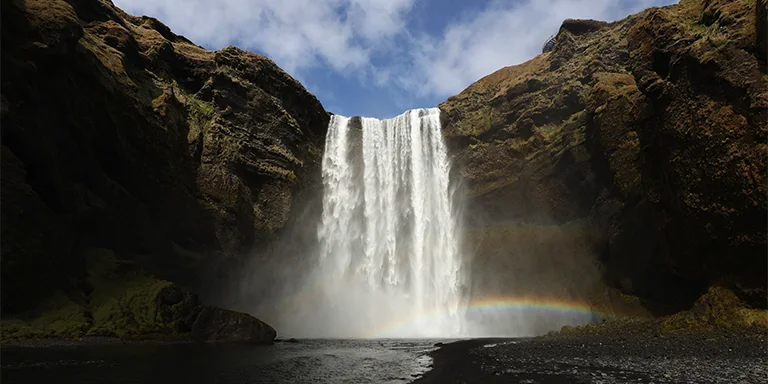
Length: 50.6 mi / 81.4 km
Type: Point to point
Difficulty: Hard
Elevation Gain: 11492 ft / 3503 m
Location: Skógar
Estimated Hiking Calorie Burn: 6460 calories
More Details: See on AllTrails
The challenging 50-mile Fimmvörðuháls trail traverses between two of Iceland’s most famous sites – the dramatic Skógafoss waterfall and the rugged Laugavegur trail. Trek across rocky ground with little vegetation past steaming volcanic vents and crater lakes. Take in panoramic views of surrounding glaciers and mountains as you cross between glacial tongues. Descend the massive Skógafoss waterfall before entering the rocky terrain. Experience the raw, isolated beauty of Iceland’s highlands on this demanding yet rewarding thru-hike. Camp at designated sites or stay in mountain huts. Hike from June to August when weather is mildest.
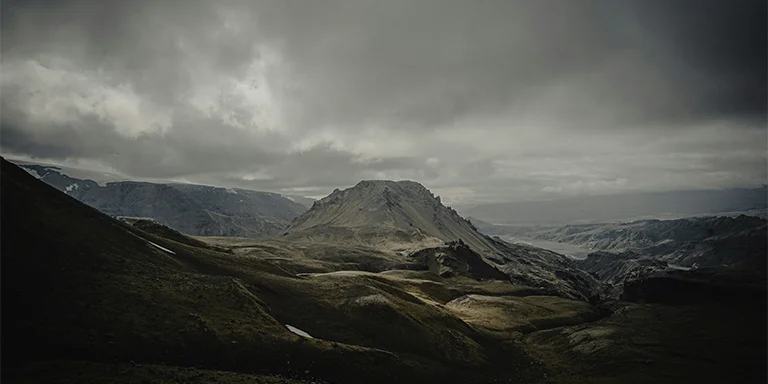
Length: 49.4 mi / 79.5 km
Type: Point to point
Difficulty: Hard
Elevation Gain: 9691 ft / 2954 m
Location: Fjallabak Nature Reserve
Estimated Hiking Calorie Burn: 6150 calories
More Details: See on AllTrails
Trek from Landmannalaugar across rugged volcanic terrain to Þórsmörk, then onward over the Fimmvörðuháls pass to Skógafoss waterfall. This challenging 49 mile thru-hike traverses the iconic Laugavegur and Fimmvörðuháls trails. Take in colorful mountains, lava fields, and river crossings, enjoying solitude on the remote interior highlands. Camp at designated sites or stay in mountain huts. Avoid the high elevation huts as conditions can become treacherous. Check forecast and get advice from local wardens – weather is unpredictable. Hike July to September when Iceland’s interior is most accessible.
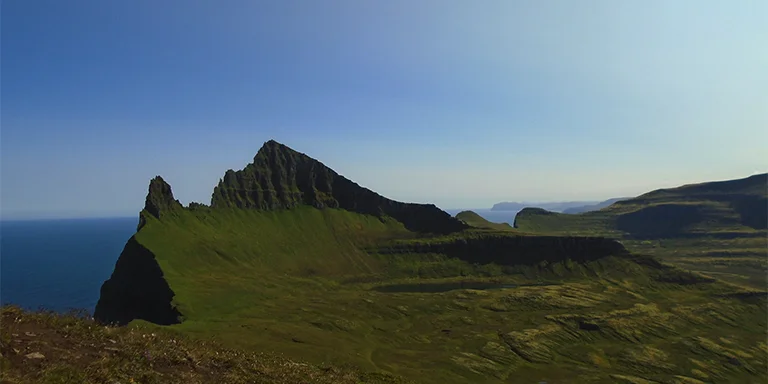
Steenaire, CC BY-SA 2.0, via flickr
Length: 52 mi / 83.7 km
Type: Point to point
Difficulty: Hard
Elevation Gain: 11 765 ft / 3586 m
Location: Hornstrandir
Estimated Hiking Calorie Burn: 6600 calories
More Details: See on AllTrails
Embark on a challenging 52-mile thru-hike across Iceland’s remote Hornstrandir Nature Reserve. To reach the trailhead, take a ferry to this isolated peninsula. Traverse unmarked wilderness trails past stunning seascapes and cliffs teeming with birdlife. Cross difficult river crossings and rocky beaches. Bushwhack through marshes and mud. Experience solitude and tranquility in Iceland’s northernmost peninsula. This demanding, unmarked route requires advanced navigation skills and wilderness experience. Hike in summer when ferry access allows.
Iceland’s weather can be quite unpredictable and variable throughout the year:
Before you grab your backpack and head outdoors, take a look at the weather statistics for Iceland (Reykjavík):
| Jan | Feb | Mar | Apr | May | Jun | Jul | Aug | Sep | Oct | Nov | Dec | |
|---|---|---|---|---|---|---|---|---|---|---|---|---|
| High °F | 36 | 37 | 38 | 42 | 49 | 54 | 56 | 56 | 51 | 44 | 39 | 37 |
| Low °F | 28 | 29 | 29 | 33 | 39 | 45 | 48 | 47 | 42 | 36 | 32 | 29 |
| Rain/Snow (D*) | 16 | 16 | 15 | 12 | 10 | 9 | 10 | 12 | 14 | 14 | 14 | 16 |
Whenever you go, be prepared with layered clothing. For accessibility and weather conditions that facilitate immersing yourself in Iceland’s majestic landscapes, aim for the summer.
Not sure if Iceland is right for you?
Don’t forget to check out our backpacking guides for Scotland and Norway.
Campfires are allowed while camping in Iceland, but with important rules to follow. Fires must be built away from vegetation in an established fire pit or stone ring, kept small, never left unattended, and fully extinguished with water after use. It’s critical to check area regulations, as campfires may be restricted during dry conditions when the fire risk is high.
When backpacking in Iceland, key safety tips include: checking weather and trail conditions regularly and being prepared to alter plans; carrying proper navigational tools and knowing how to use them in case of fog or losing the trail; wearing suitable layered clothing and waterproof gear to avoid hypothermia; packing extra food/water/fuel due to minimal facilities in remote areas; crossing glacial rivers with caution and avoiding if flooded; not venturing onto glaciers without proper equipment and experience; understanding basic first aid; sharing your itinerary with someone; being wary of steep drop-offs and loose rock when hiking; and exercising caution around any sheepdogs encountered near farms. Iceland’s variable conditions and lack of infrastructure in the backcountry requires extra preparation and self-sufficiency.
When hiking in Iceland, it’s unlikely you’ll encounter any dangerous wildlife, but exercise caution if you come across Arctic foxes, reindeer, or sheepdogs. Give foxes space, as they may be aggressive if rabid. Steer clear of male reindeer during rutting season in fall when they can become aggressive. Be wary of sheepdogs, which may view you as a threat; avoid startling any sheep herds and don’t approach the dogs. If one chases you, stand still or back away slowly – don’t run. Report any concerning wildlife behaviors to local authorities.
Those backpacking in Iceland’s magnificent natural landscapes of mountains, fjords, waterfalls and hot springs can benefit from some savvy measures to explore this captivating scenery affordably. Opting for hostel dorms, hiking multi-day trails and camping in the wilderness maintains a low-cost approach to travel. Self-driving and cycling allows independent exploration of spectacular rural areas off the main ring-road while picnicking keeps fuel costs down. Free geothermal hot pools provide a relaxing soak without entry fees, and hiking up volcanic cones rewards with panoramic views over this epic scenery. With flexible multi-modal transportation and DIY food preparation, backpackers can maximize their nature discovery amid Iceland’s splendors on a budget.
U.S. citizens do not need a visa for visits of up to 90 days within a 180-day period to Iceland. With a valid U.S. passport, you can enter Iceland for purposes of tourism without obtaining any additional documents or clearance in advance.
The prime season for trekking in Iceland is July through September. This Nordic landscape thaws during the summer months, opening access to the rugged interior with its volcanic peaks, glaciers, and vast wilderness. The weather is mildest, with highs around 59°F (15°C), though be prepared with proper gear as conditions can still be harsh at anytime. Long summer days allow ample time to capture incredible photography of the stunning landscapes. Bring quality raingear, warm layers, and a sturdy sleeping bag for the variable weather. The minimal infrastructure and challenging terrain make this an ideal time to experience Iceland’s majestic beauty on an unforgettable backpacking adventure.